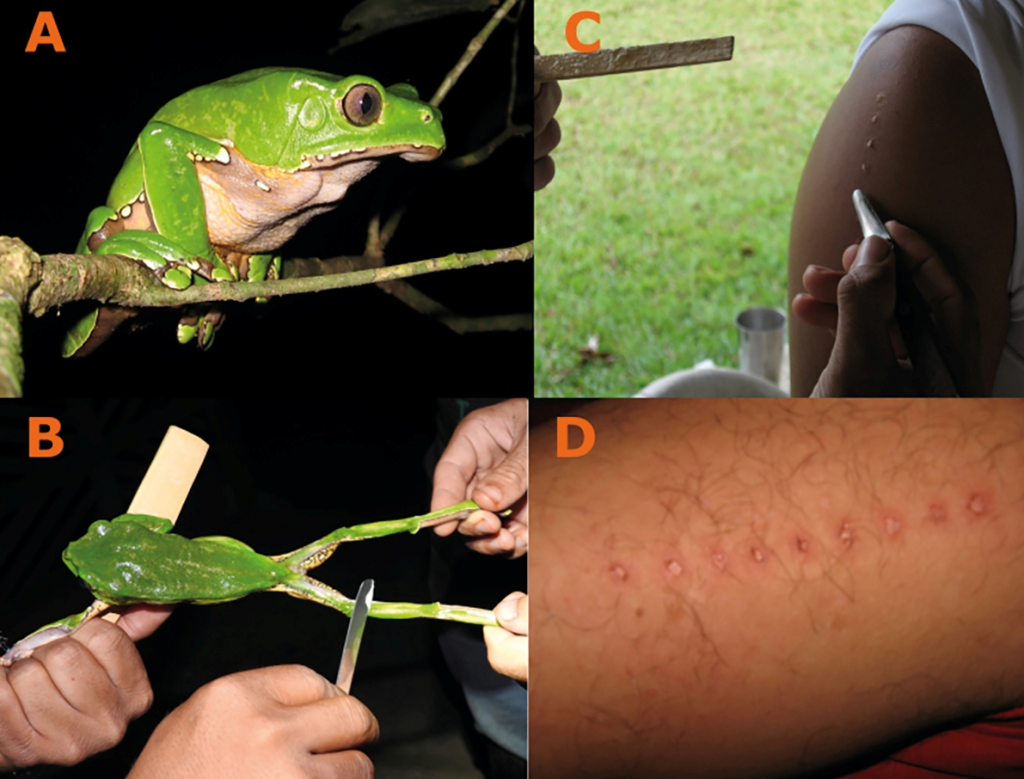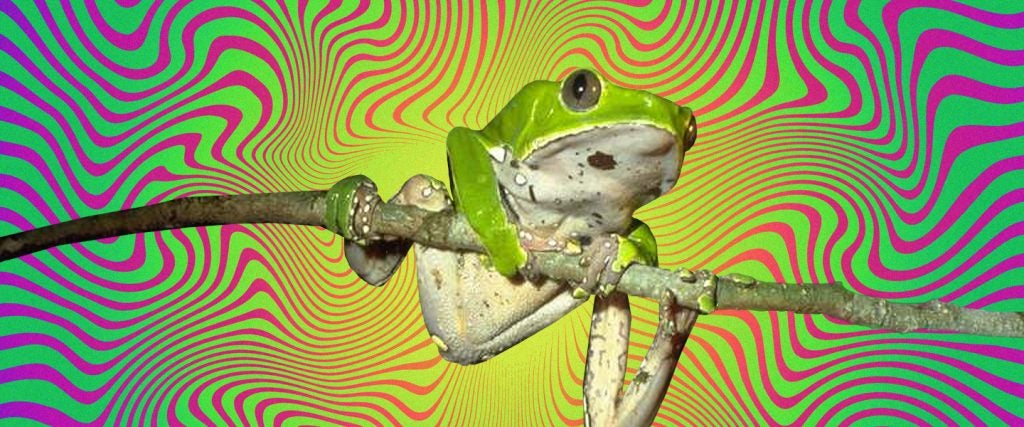About a year ago, acupuncturist Tom Ingegno sat in front of Baltimore shamans Charlotte and Undrea in an “extremely comfortable bean bag-like chair.” They burned sage and incense and smoked mapacho, a Brazilian tobacco typically used in ayahuasca ceremonies and other healing rituals.
As an acupuncturist, Ingegno was no stranger to alternative medicine and met Undrea, who goes by Dre, through his practice years prior. But after struggling with his mental health in quarantine, he wanted to try something new. So he asked if the pair could help him cleanse his negative emotions by dropping Kambo, the toxic secretion of the South American giant monkey frog, also known as the giant leaf frog, directly into open wounds on his chest.
First, Dre and Charlotte made him chug a gallon of water. Then, after he removed his shirt, Dre burned nine small dots into Ingegno’s chest with a small twig. “Next, a small amount of dried frog venom was placed in each spot,” Ingegno recalls. Dragon’s blood resin was placed to seal and disinfect the burns. (Dragon’s blood is a resin found naturally in plants that’s been used to treat wounds in some folk medicine.)

Ingegno felt a warm sensation take over his body and instinctively grabbed a bucket. He began vomiting violently for about 15 minutes, though he stressed that it “felt like hours.” Afterwards, feeling awful, Dre covered him with blankets. About 10 minutes later, he began to smile and popped back up.
As Ingegno recovered, he and Dre discussed the origins of Kambo, which trace back to a story from the Kaxinawá tribe in Brazil. (Dre isn’t Brazilian himself and grew up in Maryland, though he did study under a shaman in Brazil.) As Ingegno recalls — and other shaman and plant medicine practitioners confirm — the legend goes that the village had fallen ill and after other remedies had failed, a medicine man by the name of Kampu went into the jungle to drink ayahuasca and brainstorm solutions. A female spirit appeared holding a frog, and showed him how to apply it. From that point on, the tribe used it as a “vaccine” to deal with sickness, bad luck and to enhance their hunting capabilities.
While the first documented tribal use was in 1925, those who use Kambo these days do so mainly for psychological problems and other chronic health issues traditional medicines may not effectively address. Ingegno says he noticed the benefits right away, feeling more energized and less depressed. After trying Kambo twice more in the coming months, he found that the violent vomiting got easier. In fact, the harder part was finding an open slot to schedule follow-up appointments due to the increasing popularity of “frog medicine,” he says.
“There is way more demand than I can meet as a practitioner,” San Diego-based Kambo practitioner Caitlin Thompson tells me. Kambo is currently an entirely unregulated, unscheduled, technically legal drug in the U.S., so it’s easier to come by than mushrooms or ayahuasca, and it produces zero hallucinogenic or intoxicating effects.
Beyond that, “I think people are turning to Kambo because it works for things that many conventional medical treatments fail at treating,” says Thompson, who tried Kambo for the first time in 2016 and found it helped her cope with a number of chronic conditions, including Lyme disease, fibromyalgia and post-traumatic stress disorder. Indeed, Kambo proponents boast that the frog fluids can treat everything from anxiety and depression to Alzheimer’s — though none of this has been confirmed by peer-reviewed research. (In fairness, no such experiments have been attempted either; currently, a majority of the data on Kambo is limited to case studies looking at the toxicity and risk of sudden death.)
Kambo enthusiasts and the occasional scientist attribute potential benefits to the high concentration of bioactive neuropeptides found in Kambo, but researchers believe that’s also what results in such a violent reaction. Neuropeptides are chemical messengers in the body that are larger than neurotransmitters and made up of amino acids. They help regulate a range of functions, including cognition, blood pressure, metabolism, pain and stress, while also supporting the immune system and protecting the brain. Thus, the high concentration of neuropeptides is what Kambo proponents attribute to the broad benefits of the substance.
When applied through open wounds, neuropeptides cause a reaction that’s “sometimes interpreted as results of an intoxication or a massive allergic reaction, which clearly they are not,” researcher Jan Keppel Hesselink explains in a review of the literature on Kambo. Instead, Hesselink attributes the response to an “intense pharmacological effect” of so many bioactive neuropeptides, “which most probably act synergistically.” “In Kambo there are many peptides, which can have important contributions in the clinic,” Hesselink concludes.
At the same time, many experts still consider Kambo to be nothing short of poison that comes with the risk of dehydration from violent bouts of vomiting and diarrhea, convulsions, seizures and even jaundice. In extreme instances, there have been reports of death following Kambo, including one woman in New South Wales who died of cardiac arrest after a procedure in 2019. For this reason, the substance — known in the medical community as phyllomedusa bicolor — was recently banned and listed as a schedule 10 poison in Australia, the most dangerous of drug classifications in the country.
“In addition to its harmful effects both intended and adverse, the act of blistering the skin and applying Kambo to the burnt area risks other health concerns such as infection,” the Australian Medical Association wrote in a submission to the domestic Therapeutic Goods Administration, which classifies drugs. “There is also a risk that using Kambo would prevent a patient from seeing a medical practitioner for their medical condition and delay diagnosis.”
Thompson, who has a background in neurobiological research at the University of California, San Diego and San Diego State University, insists that Kambo is “remarkably safe.” Still, even she was skeptical when she heard about frog medicine being used on an ayahuasca retreat in Peru in 2011. But she tried it five years later on the recommendation of a friend and found it much more profound than she ever expected. “I was just starting to realize how sick I had been my whole life,” she says. “Kambo gave me health and vitality and showed me a clear contrast between how I had been living, and how I could be living.”
Over the next few years, Thompson continued to self-administer frog toxins through dots in her skin, also known as “transdermal administration.” This allows it to be quickly absorbed into the bloodstream while honoring a traditional practice. It’s also thought to be administered this way because it makes the dosage more manageable. “Other methods seem to allow too high of doses into the body for safe use,” Thompson says. “There is a rumor of something called ‘frog sickness’ when it’s consumed orally, or intranasally.”
When strangers started requesting Thompson for Kambo guidance a little over six years ago, she signed up for the International Association of Kambo Practitioners training program, a two-week intensive course, in addition to traveling to the Amazon to study Kambo’s traditional uses with the Matses tribe. However, “real skill as a practitioner is earned through experience,” says Thompson, who reports having a 100 percent safety record over the course of 1,400 treatments, along with publishing two studies on the topic, with a third on the way.
That said, Thompson admits that Kambo is “quite unregulated” and some people “just purchase Kambo off the internet and decide they’re a practitioner.” She believes this lack of regulation gives Kambo a bad name and inflates the risk when “the medicine itself is remarkably safe despite so much practitioner negligence and ignorance.” “I’m not suggesting that Kambo should necessarily be regulated like a drug or medication, but I’m just commenting on some of the consequences of it being 100 percent wild, wild West,” Thompson explains. “Education and community accountability is the answer. And adequate leadership, which the community severely lacks.”
As far as sustainability goes, the giant monkey frog’s population is currently stable and mucus can be collected without harming the animals, but “if you’re not there doing it yourself, you can’t really know,” Thompson notes. Needless to say, the more popular Kambo becomes, the greater the potential environmental impact. To that end, Thompson worries Kambo’s popularity could play a hand in “changing the dynamics of the indigenous populations, as they become more interested in harvesting and selling the medicine to support their tribes.” Her hope is that with more education and scientific studies, “a synthetic Kambo-inspired peptide cocktail” might be developed.
For his part, Ingegno reports feeling less depressed and anxious and more clearheaded and focused than before he started using Kambo. At the same time, he’s not rushing to book a fourth Kambo ceremony anytime soon. So while he does recommend Kambo as an option for people who have been failed by conventional remedies, the trade-off is 15 minutes of puking with no high whatsoever. Or as he warns, “It isn’t something you’d want to enter into lightly, and it certainly doesn’t promise a fun trip.”

